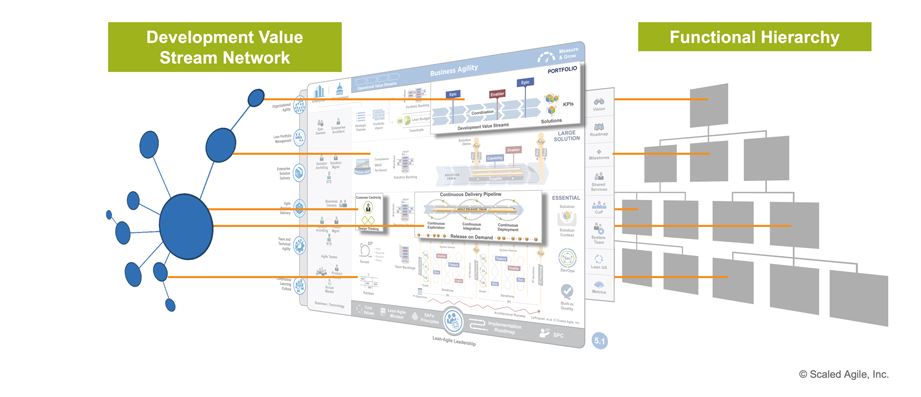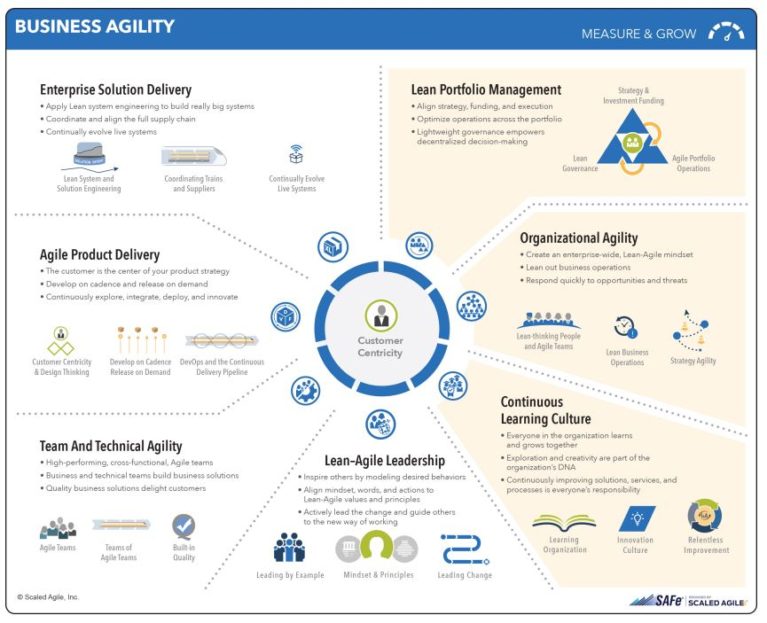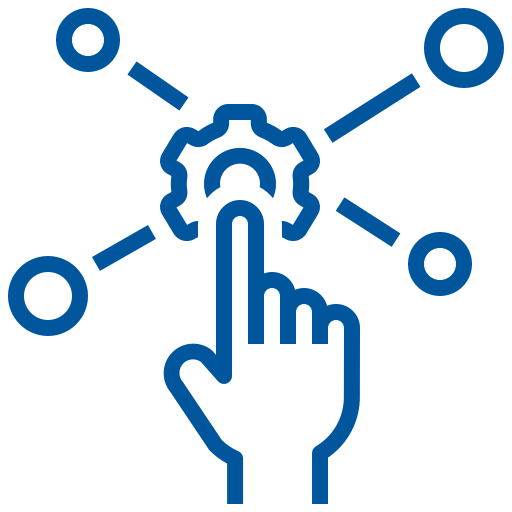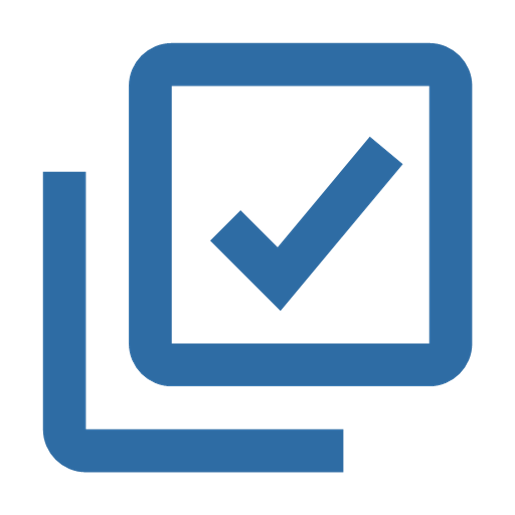SAFe® - agile scaling in business
Competitiveness means controlled adaptation to a working environment that is constantly changing.
Agility and Stability
John Kotter, change management guru and lecturer at Harvard Business School, described it back in 2014.
In his book “Accelerate: Building Strategic Agility for a Faster-Moving World”, Kotter writes that companies can meet the current rapidly changing and ever more demanding requirements of their environment and the need to ensure the stability of operations with a dual operating system. Traditional hierarchically organized companies quickly reach their limits when they need to react efficiently and effectively to the ever-increasing pressure to change in an ever shorter time.

Scaled Agile Framework (SAFe®)
SAFe® provides a framework of fundamental principles, processes, and best practices.
SAFe® is based on approaches from Lean, Kanban, Scrum and the agile manifesto. SAFe® promotes the dual operating system in organizations and bridges the gap between scaling agility and ensuring stable operations. This means that parallel to the classical hierarchies, the agile framework can be used at different levels (portfolio, large solution, program and team) in the organization. SAFe® is built on agile teams that work on feature-derived stories in a process-oriented and collaborative cadence, reliably delivering value in short cycles.
Core Competencies and Principles
SAFe® describes 7 core competencies and 10 principles that are essential to business agility.
The 7 core competencies described in SAFe put the customer at the centre.
Enterprise Solution Delivery, focuses on lean governance with decentralized decision-making and alignment of strategy, funding and operations, Agile Product Delivery, represents equally lean system and solution engineering that aligns the entire supply chain, and Lean Portfolio Management, describes the continuous development, integration, delivery and innovation of customized solutions.
This requires Organizational Agility, an organization that can react quickly to opportunities and risks, Team and Technical Agility, interdisciplinary agile teams that want to inspire the customer with their solutions, and Lean Agile Leadership, leaders who are role models, implement agile principles and values in their behaviors, and guide employees in the transformation to the new way of working.
The organization is also characterized by a Continuous Learning Culture. Learning and growing together are just as much a part of this culture of innovation as striving for continuous improvement of solutions, services and processes.

At the heart of the SAFe® framework there are also 10 principles. They are derived from principles defined by Don Reinertsen to ensure a profitable flow of development.

Take an economic standpoint
The framework is based on an understanding of the entire value chain and focuses on its continuous optimization. Otherwise, even a technically sophisticated system may incur excessive development costs and delivery times, or generate exorbitant manufacturing or operating costs.

Thinking in Systems
Systems thinking means maintaining a holistic view throughout the entire development cycle of a solution. All components of a system as well as its surrounding systems are included in the design, development, deployment and maintenance of the system.

Predict variability and preserve options
Systems should be designed in such a way that they allow and can use variability. Decisions can thus be made later and different options retained until more information or experience is available to make a decision.

Build incrementally with rapid, integrated learning cycles
In short planning cycles, quick feedbacks are given, growing uncertainties are avoided and additional knowledge and experience are gained.

Define milestones based on objective assessments
The system is built increment by increment, with each increment corresponding to a measurable milestone that is defined as a value-added part of the overall solution.

Visualize and limit Work In Progress (WIP), reduce work packages, and control the backlog
Small work packages (batch sizes) are processed sequentially and are visible to all stakeholders (Kanban). This reduces long cycle times, minimizes quality losses and increases the motivation of all involved.

Apply cadence and synchronize across range boundaries
Cadence and synchronization are the tools to ensure a controlled development flow in the overall organization. Systems are built and developed in a regular rhythm (iterations). Cadence helps to predict waiting times, minimize transaction costs and increase the reliability of product development.

Fostering the Intrinsic Motivation of Professionals
Professionals are people who know more about the work they do than their supervisors. Employees generally work most efficiently when they are given challenging work and extensive freedom to carry it out.

Decentralized Decision-Making
Decisions have to be made continuously during development. Delayed decisions have a negative impact on quality and delivery times. Decentralized decisions are delegated to the value streams and take place in the iteration plannings and daily meetings, for example.

Value-Oriented Organization
SAFe® describes how the dual operating system enables the company to organize itself and optimize value creation. Important components in the implementation are the portfolios in the value streams (Value Streams), the value-oriented Agile Release Trains (ARTs) and the agile teams that directly deliver value.

Benefits of SAFe®
SAFe® is a globally recognized framework when it comes to designing the overall organization according to agile principles. It places great emphasis on efficiency and employee satisfaction.
- SAFe® is widely used worldwide, has a high acceptance rate and a very active community.
- SAFe® describes all elements in great detail and is freely available at the link https://www.scaledagileframework.com.
- SAFe® enables companies to scale agile methods and thus implement the transformation into an agile organization.
- Companies can use SAFe® to manage their projects in an agile way and stakeholders can provide feedback faster across teams. This increases the productivity and satisfaction of the employees.
- SAFe® promotes transparency and intensive exchange in the entire organization.
- SAFe® enables increased productivity and faster time to market.
Weaknesses of SAFe®
SAFe® is not a no-brainer. It requires an intense engagement with the framework and a willingness to engage in this agile transformation journey without compromise.
- SAFe® is complex and not easy to implement.
- SAFe® forces the employee to deal intensively with the framework, otherwise the processes, roles, principles and competences are difficult to understand.
- SAFe® takes a strong top-down approach while advocating for self-organized teams.
- Due to its complexity and scalability, SAFe® requires a lot of forward planning and clear process definitions.

Our fields of activity
We accompany the introduction of SAFe® process-oriented, organizational and on team level.
The various service modules are shown below,
Introducing SAFe®
We support companies in the introduction of SAFe® with the following services:
- Current Situation (Baseline)
- Analysis of requirements and challenges
- Conducting an Agility Maturity Assessment
- Development of an implementation concept
- Conducting training
- Support in the implementation of the SAFe® implementation concept
- Support continuous learning and improvement
SAFe® Support
We support companies in optimizing and extending the SAFe® framework with the following services:
- Coaching and mentoring of agile teams and employees who hold specific SAFe® roles
- Assessments of SAFe® processes, events and agile behavior
- Development of a catalogue of measures to optimize the SAFe® implementation or its extension
SAFe® Team Collaboration
We use our Agile Behavioral Change Framework to optimize collaboration. The details can be found here. Services include:
- Capture of current collaboration quality
- Formulation of team goals and team values
- Reflect desired behaviors with our psychological app aspecx
- Retrospective using data-based visualizations to drive momentum
Competence, experience and transparent costs – our offer
We guarantee project management with certified project managers, comprehensive methodological competence and a human-centered attitude.
We work in a structured, data-based manner and with a transparent cost structure. Regular reports show the progress of the project in terms of agreed deliverables and costs incurred. Adjustments can be made as promptly and agilely as needed.

Standards and Good Practices
- SAFe® Certification
- SCRUM Master Certification
- ITIL V4 Certification
- Many years of experience supporting SAFe® implementations
- Long-term experience in supporting agile teams

People-centered approach
- Humans and their behaviors are at the center
- Collaboration-centered project management
- Promoting mutual understanding and empathy

Transparent cost structure
- Modular structure of SAFe® services
- Tailored service packages
- Continuous cost control

Psychological know-how
- Optimising collaboration with the Agile Behavioural Change Framework
- Psychological app aspecx as a reflection tool
- Individual coaching

Are you on your way to becoming an agile company?
Edo Bezemer – I invite you to a joint analysis of the initial situation in a consultation with me.
In a personal conversation, I will explain to you which services we can offer you within the framework of SAFe®, what experience we can bring to the table, and what the next steps might be.
Feel free to contact me via email or call +41 61 508 15 19